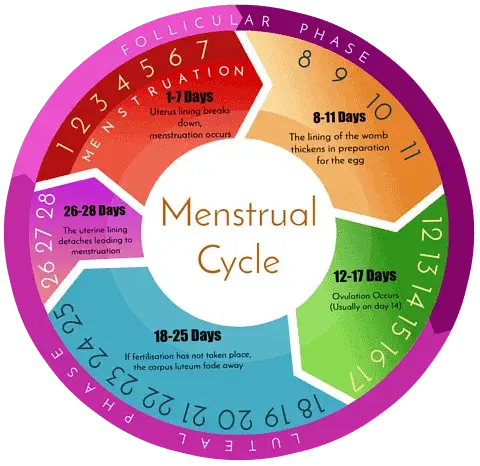The menstrual cycle is a natural process that occurs in the female reproductive system and involves a complex interplay of hormones that prepare the body for potential pregnancy. Understanding the menstrual cycle is important for many reasons, including tracking fertility and predicting the arrival of periods. Additionally, knowledge of a typical menstrual cycle can help identify any changes or irregularities that may require medical attention.
In this blog post, we will provide a comprehensive guide to understanding the menstrual cycle. We will cover the menstrual cycle hormones and functions throughout the menstrual cycle, from the menstrual phase to the luteal phase. We’ll also explore common concerns that women may have, such as changes to the menstrual cycle and how to determine the last day of a period. By the end of this post, you’ll have a better understanding of your body and how it functions during the menstrual cycle.
Throughout this guide, we will cover the following topics:
- What is the menstrual cycle and its phases?
- Menstrual cycle hormones and functions
- The luteal phase of the menstrual cycle
- What causes a shorter menstrual cycle?
- Understanding menstrual cycle days and phases
- How to determine the last day of your period
With this information, you’ll have a better understanding of your menstrual cycle and be better equipped to manage any issues that may arise. So, let’s dive into the menstrual cycle and its intricacies.
What is the Menstrual Cycle?
The menstrual cycle is the process that occurs in the female reproductive system and prepares the body for potential pregnancy. The menstrual cycle begins on the first day of menstruation and ends with the start of the next menstrual period.
4 phases of menstrual cycle:
The menstrual phase, the follicular phase, the ovulatory phase, and the luteal phase. Each phase is regulated by different hormones and plays a specific role in preparing the body for pregnancy.
Menstrual phase:
The menstrual phase is the first phase of the menstrual cycle and lasts for about 3-7 days. During this phase, the uterus sheds its lining, causing bleeding. This phase is regulated by the hormone progesterone.
Follicular phase:
The follicular phase is the second phase of the menstrual cycle and lasts for about 7-10 days. During this phase, the body prepares for ovulation by stimulating the growth of follicles in the ovaries. This phase is regulated by the hormone estrogen.
Ovulatory phase:
The ovulatory phase is the third phase of the menstrual cycle and lasts for about 3-5 days. During this phase, the mature follicle releases an egg, which can be fertilized by sperm. This phase is regulated by the luteinizing hormone (LH) and follicle-stimulating hormone (FSH).
Luteal phase:
The luteal phase is the final phase of the menstrual cycle and lasts for about 10-14 days. During this phase, the body prepares for pregnancy by producing more progesterone, which helps thicken the lining of the uterus. If the egg is not fertilized, the levels of hormones drop, and the menstrual cycle starts again with the menstrual phase.
To help you visualize the menstrual cycle, here’s a basic diagram:

Understanding menstrual cycle and its phases is crucial for tracking fertility, identifying irregularities, and managing menstrual-related issues. Let’s move on to the next section to learn about the hormones involved in the menstrual cycle.
You may like: Home Exercises To Reduce Breast Size
Hormonal Changes during the Menstrual Cycle
The menstrual cycle is regulated by several hormones, including estrogen and progesterone. These hormones work together to control the different phases of the menstrual cycle and prepare the body for pregnancy.
- Estrogen: Estrogen is a hormone produced by the ovaries during the follicular phase of the menstrual cycle. It helps stimulate the growth of the uterine lining, prepare the cervix for sperm, and promote the maturation of the egg. Estrogen levels peak just before ovulation and drop sharply afterward.
- Progesterone: Progesterone is a hormone produced by the corpus luteum during the luteal phase of the menstrual cycle. It helps thicken the uterine lining, reduce the contractions of the uterus, and prepare the body for pregnancy. If the egg is not fertilized, progesterone levels drop, triggering menstruation.
During the menstrual cycle, hormonal changes affect the body in different ways, depending on the phase of the cycle. Here’s a summary of how hormonal changes affect the body during each phase of the menstrual cycle:
Menstrual phase:
During the menstrual phase, estrogen and progesterone levels are low, triggering the shedding of the uterine lining and causing menstrual bleeding.
Follicular phase:
During the follicular phase, estrogen levels rise, stimulating the growth of follicles in the ovaries and thickening the uterine lining.
Ovulatory phase:
During the ovulatory phase, LH and FSH levels surge, triggering the release of the mature egg from the ovary. Estrogen levels also peak during this phase, promoting ovulation.
Luteal phase:
During the luteal phase, progesterone levels rise, thickening the uterine lining and preparing the body for pregnancy. If the egg is not fertilized, progesterone levels drop, triggering menstruation.
Understanding the hormonal changes that occur during the menstrual cycle is essential for identifying irregularities and managing menstrual-related issues. Let’s move on to the next section to learn about the luteal phase of the menstrual cycle.
Also read: Say Goodbye to Oily Skin this Summer: Your Ultimate Skincare Guide
The Luteal Phase of the Menstrual Cycle
The luteal phase is the final phase of the menstrual cycle and begins immediately after ovulation. It lasts for approximately 14 days and is characterized by the presence of the corpus luteum, a temporary endocrine structure that forms in the ovary after ovulation.
During the luteal phase, hormonal changes continue to occur, mainly involving progesterone and estrogen. Here’s a detailed explanation of the luteal phase and how hormonal changes can affect a woman’s body:
- Formation of the corpus luteum: After ovulation, the ruptured follicle in the ovary transforms into the corpus luteum, which produces and secretes progesterone.
- Progesterone levels rise: As the corpus luteum grows, it produces increasing amounts of progesterone, which thickens the uterine lining and prepares the body for pregnancy.
- Estrogen levels decline: As progesterone levels rise, estrogen levels decrease.
- Body temperature increases: Progesterone can cause a slight increase in basal body temperature (BBT), which can be tracked to identify ovulation and monitor fertility.
- PMS symptoms may occur: Progesterone can cause premenstrual syndrome (PMS) symptoms, including mood swings, breast tenderness, bloating, and acne.
- Pregnancy may occur: If fertilization occurs, the fertilized egg will implant in the thickened uterine lining during the luteal phase.
- Progesterone levels drop: If the egg is not fertilized, the corpus luteum will eventually degenerate, causing a drop in progesterone levels. This drop triggers the onset of menstruation and marks the beginning of a new menstrual cycle.
Understanding the luteal phase and the hormonal changes that occur during this phase is important for identifying irregularities in the menstrual cycle and addressing issues such as PMS and fertility problems. In the next section, we will discuss why some women may experience a shorter menstrual cycle.
Changes to the Menstrual Cycle
Women may experience changes to their menstrual cycle throughout their reproductive years. These changes can include alterations in the length of the cycle, the duration of bleeding, and the regularity of periods. While some changes are normal and may not require medical attention, others can indicate underlying health issues or hormonal imbalances.
One common concern that women may have is a shorter menstrual cycle. Normally, the menstrual cycle lasts between 21 to 35 days, with an average of 28 days. If a woman’s menstrual cycle consistently falls outside this range, it may be a cause for concern. Here are some potential explanations and solutions for a shorter menstrual cycle:
Hormonal imbalances:
Fluctuations in hormone levels can affect the menstrual cycle, including the length of the cycle. Hormonal imbalances can be caused by various factors, such as stress, weight changes, thyroid problems, and polycystic ovary syndrome (PCOS).
Perimenopause:
Women approaching menopause may experience shorter menstrual cycles due to changes in hormone production.
Birth control:
Some types of birth control, such as hormonal contraception or intrauterine devices (IUDs), can cause changes to the menstrual cycle, including a shorter cycle.
Endometriosis:
This condition occurs when tissue similar to the lining of the uterus grows outside the uterus, causing pain, heavy bleeding, and changes to the menstrual cycle.
If a woman is experiencing a consistently shorter menstrual cycle or other irregularities, she should consult with her healthcare provider. Treatment options will depend on the underlying cause of the changes.
In conclusion, understanding the menstrual cycle and the potential changes that can occur is important for maintaining reproductive health. By monitoring changes and seeking medical attention when necessary, women can ensure that their menstrual cycle is functioning properly and address any issues that may arise.
Menstrual Cycle Days
Understanding how menstrual cycle days are counted and what is considered a normal range for the length of a menstrual cycle is important for women to monitor their reproductive health. In this section, we will explain how menstrual cycle days are counted and discuss what is considered a normal range for the length of a menstrual cycle.
A. Counting Menstrual Cycle Days
The menstrual cycle can be counted in different ways, but the most common method is counting from the first day of menstrual bleeding to the first day of the next menstrual period. For example, if a woman starts bleeding on June 1 and starts bleeding again on June 29, her menstrual cycle would be considered 28 days long.
B. Normal Range for Menstrual Cycle Length
The length of the menstrual cycle can vary from woman to woman and can even vary for the same woman from month to month. On average, a menstrual cycle lasts between 21 and 35 days, with an average of 28 days. However, some women may have cycles that are shorter or longer than this range, and this can be considered normal as long as they are consistent.
C. Differentiating Menstrual Cycle Days from Period Days
It’s important to note that the length of the menstrual cycle is not the same as the length of the period. The period typically lasts between 2 and 7 days, with an average of 5 days.
D. Tracking Menstrual Cycles
Tracking menstrual cycles can be helpful for monitoring reproductive health and identifying any changes or irregularities. There are various methods for tracking the menstrual cycle, such as using a calendar, a period-tracking app, or a fertility tracker. Women can use these tools to record the start and end dates of their periods and calculate the length of their menstrual cycle over time.
In conclusion, understanding how to count menstrual cycle days, what is considered a normal range for the length of a menstrual cycle, and how to track menstrual cycles can help women monitor their reproductive health and identify any changes or irregularities. Women should consult with their healthcare provider if they experience any concerns or questions about their menstrual cycle.
Menstrual Cycle Phases
The menstrual cycle can be divided into four phases: menstrual phase, follicular phase, ovulatory phase, and luteal phase. In this section, we will provide a detailed breakdown of each phase and discuss the hormonal changes and physical symptoms that may occur during each phase.
Menstrual Phase:
The menstrual phase, also known as the bleeding phase, is the first phase of the menstrual cycle. This phase starts on the first day of bleeding and lasts for approximately 3-7 days. During this phase, the uterus sheds its lining, and the menstrual blood is released through the vagina. Hormonal changes during this phase are characterized by low levels of estrogen and progesterone, which can cause physical symptoms such as cramps, bloating, and fatigue.
Follicular Phase:
The follicular phase begins on the first day of the menstrual cycle and lasts until ovulation. This phase is characterized by the development of follicles in the ovaries, which produce estrogen. As estrogen levels increase, the lining of the uterus thickens, preparing for a potential pregnancy. Physical symptoms during this phase may include mood swings, breast tenderness, and increased sex drive.
Ovulatory Phase:
The ovulatory phase is the midpoint of the menstrual cycle and occurs when a mature egg is released from the ovary. This typically happens around day 14 of a 28-day cycle, but it can vary. During this phase, estrogen levels peak, which triggers a surge in luteinizing hormone (LH), causing the egg to be released. Physical symptoms during this phase may include abdominal pain or cramping, changes in cervical mucus, and a slight increase in basal body temperature.
Luteal Phase:
The luteal phase begins after ovulation and lasts until the start of the next menstrual cycle. During this phase, the follicle that released the egg transforms into the corpus luteum, which produces progesterone. Progesterone levels rise and estrogen levels decrease, causing the lining of the uterus to thicken even more, preparing for implantation of a fertilized egg. If fertilization does not occur, the corpus luteum disintegrates, progesterone levels decrease, and the lining of the uterus sheds during the next menstrual cycle. Physical symptoms during this phase may include breast tenderness, bloating, and mood swings.
In conclusion, understanding the four phases of the menstrual cycle and the hormonal changes and physical symptoms that may occur during each phase can help women better understand and manage their menstrual cycles. Women should consult with their healthcare provider if they experience any significant changes or irregularities in their menstrual cycle.
The Last Day of a Period
Tracking the last day of a period is an important part of understanding the menstrual cycle and fertility. Here are some key points to consider:
Determining the Last Day of a Period
- The last day of a period is typically the day when menstrual bleeding stops completely.
- It’s important to note that spotting or light bleeding that occurs after the period has ended is not considered part of the menstrual cycle.
Why It’s Important to Track the Last Day of a Period
- Tracking the last day of a period can help women identify the length of their menstrual cycle and predict when the next period is likely to occur.
- This information is also important for tracking fertility, as ovulation usually occurs around 14 days before the start of the next menstrual cycle. By knowing the last day of their period, women can estimate when they are most fertile and plan accordingly.
Overall, understanding the last day of a period is a key component of monitoring the menstrual cycle and fertility. By keeping track of this information, women can gain a better understanding of their bodies and make informed decisions about their reproductive health.
Menstrual Hygiene
Maintaining good menstrual hygiene is crucial for women’s health and well-being. Here are some key points to consider:
Menstrual Hygiene Products
- There are several types of menstrual hygiene products available, including pads, tampons, and menstrual cups.
- Each product has its own advantages and disadvantages, and women should choose the product that best fits their individual needs and preferences.
- It’s also important to change menstrual hygiene products regularly to prevent the buildup of bacteria and reduce the risk of infection.
Tips for Maintaining Good Menstrual Hygiene
- Wash hands thoroughly before and after changing menstrual hygiene products.
- Change pads or tampons at least every 4-6 hours, or more frequently if necessary.
- Consider using fragrance-free products to reduce the risk of irritation or allergic reactions.
- If using a menstrual cup, make sure to follow the manufacturer’s instructions for proper insertion, removal, and cleaning.
Overall, maintaining good menstrual hygiene is an important part of staying healthy and comfortable during menstruation. By choosing the right products and practicing good hygiene habits, women can help prevent infections and other complications and enjoy a more positive menstrual experience.
FAQ
A: The menstrual cycle consists of four phases: the menstrual phase, the follicular phase, the ovulatory phase, and the luteal phase.
A: You can understand your period cycle by tracking the length of your menstrual cycle, counting the number of days between the first day of your period and the first day of your next period. You can use a calendar or a period tracking app to help you keep track.
A: The number of days before and after your period that are safe for sexual activity depends on the length of your menstrual cycle and the timing of ovulation. Generally, the fertile window (when pregnancy is most likely to occur) is 5 days before ovulation until the day of ovulation. It’s important to use contraception if you’re not trying to conceive, as sperm can live in the body for up to 5 days.
A: A typical menstrual cycle lasts between 21 and 35 days, although some women may have cycles that are shorter or longer than this range.
A: Common physical symptoms that can occur during the menstrual cycle include cramping, bloating, breast tenderness, and headaches.
A: There are several ways to alleviate menstrual cramps, including taking over-the-counter pain relievers such as ibuprofen, using a heating pad on the lower abdomen, and practicing relaxation techniques such as deep breathing or yoga.
Conclusion
Understanding the menstrual cycle is important for every woman’s health and well-being. In this post, we’ve covered the basics of the menstrual cycle, including its phases, hormonal changes, and how to track menstrual cycle days. We’ve also discussed the luteal phase, changes to the menstrual cycle, and the importance of good menstrual hygiene.
By understanding how the menstrual cycle works and what to expect during different phases, women can better manage their periods and track their fertility. It’s also important to maintain good menstrual hygiene to prevent infections and other complications.
For readers who want to learn more about the menstrual cycle and related topics, there are many resources available, including healthcare providers, online forums, and informational websites. By taking the time to learn about the menstrual cycle and taking steps to care for their bodies, women can feel more empowered and confident in managing their menstrual health.





